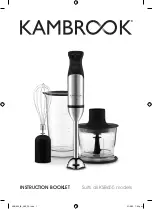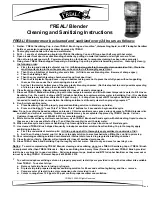
5
recommended speed chart
tool/attachment
function
speed
maximum
capacities
knife blade
One stage cake mix
2
800g/1lb 2oz total weight
Pastry - rubbing fat into flour
1 – 2
250g/9oz
Adding water to combine pastry ingredients
2
Chopping/pureeing/pates
2
300g/10oz meat
Yeasted mixes
2
340g/12oz flour weight
knife blade with
Soups and milkshakes
1 – 2
800mls/1.3pt
maxi-blend canopy
whisk
egg whites
2
6
cream
1
250mls/
1
⁄
2
pt
slicing plate/
Firm food items such as carrots, hard cheeses
2
–
shredding plate
Softer items such as cucumbers, tomatoes
1
–
citrus juicer
Citrus fruits
1
–
liquidiser
All processing
2
1 litre/1
3
⁄
4
pt
using the attachments
knife blade
This blade is the most versatile of all the attachments.
The texture you get is determined by the length of
processing time. For coarser textures use the ‘pulse’
feature checking the consistency regularly.
hints
l
Cut food such as meat, bread, vegetables into cubes
approximately 2cm/3/4in before processing.
l
Biscuits and bread should be broken into pieces and
added down the feed tube whilst the appliance is
running.
l
When making pastry use fat straight from the fridge
cut into 2cm/3/4in.cubes. Take care not to over-
process.
l
Cake Making
- Sponge type cakes are best made by
the ‘all in one method’. A ‘soft tub’ margarine used
straight from the refrigerator and cut into 2cm/3⁄4in
cubes should always be used. Process until smooth.
l
Mayonnaise - Place the egg and seasonings into the
bowl and
mix for a few seconds. With the machine
running gradually add the oil down the feed tube in a
slow steady stream.
l
Yeast dough
- Place the flour, fat and other dry
ingredients into the bowl and process for a few
seconds to mix. With the machine running add the
liquid mixture down the feed tube and continue
processing until the mixture forms a dough and
becomes smooth in appearance and elastic to touch
- this will take 45-60 seconds. Allow the dough to rise
then re-knead for 10
seconds.
whisk
Use for egg whites and cream only. The whisk is
unsuitable for other recipes. Make sure the bowl and
whisk are free from any traces of grease or egg yolk
when whisking egg whites.
slicing and shredding plates
what the cutting plates can do.
slicing plate -
slices carrots, potato, cabbage,
cucumber, courgette, beetroot, onion.
shredding plate -
grates cheese, carrot, potato and
foods of a similar texture.
to assemble the plate carrier
1 Select the desired plate and fit into the carrier with the
cutting side uppermost.
l
Locate one end of the plate under the rim and press
the other end into position. It will only fit one way
round
.
using the cutting plates
shredding plate
Cut pieces of food to fit the feed tube. Fill the tube
almost to the top and push down using the pusher
with an even pressure whilst the machine is running.
Longer shreds can be obtained by stacking pieces
horizontally in the feed tube eg carrot.
slicing plate
If necessary cut food to fit the feed tube. Core foods
such as apples and peppers. Pack the food in an
upright position in the feed tube. The height should
be slightly shorter than the feed tube. Using the
pusher, push down with an even pressure whilst the
machine is running.
hints
l
Use fresh ingredients.
l
Don’t cut food up too small. Fill the feed tube fairly
full, this prevents food from slipping sideways during
processing.
l
When slicing or shredding: food placed upright
comes out shorter than food placed horizontally.
l
After using a cutting plate there will always be a small
amount of waste on the plate or in the food.
l
Do not allow food to build up to the underside of the
plate - empty regularly.
l
Push food down the feed tube using an even
pressure.
Содержание FP190 series
Страница 1: ...FP190 series instructions ...
Страница 3: ... ...
Страница 4: ... ...
Страница 90: ......
Страница 91: ...19030 6 HEAD OFFICE Kenwood Limited 1 3 Kenwood Business Park New Lane Havant Hampshire PO9 2NH ...









































